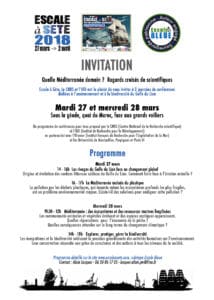Tomorrow, what kind of Mediterranean? Scientists' views
This event is over!
Festival lectures Stopovers in Sète
Tuesday March 27 and Wednesday March 28, 2018
 Two days of conferences dedicated to the environment and biodiversity of the Gulf of Lion.
Two days of conferences dedicated to the environment and biodiversity of the Gulf of Lion.
A program of conferences for all offered by the CNRS (Centre national de la recherche scientifique) and theIRD (Development Research Institute) in partnership withIFREMER (French Research Institute for Exploitation of the Sea), and the Universities of Montpellier, Perpignan and Paris VI.
Conference "Coastal ocean circulation, from regional to coastal scale. Example of the Gulf of Lion."
By Yann Lerrede, Senior Lecturer, University of Montpellier - Geosciences Laboratory
Marine currents vary according to the scale at which they are studied. The North Mediterranean Current, which runs east-west along the Ligurian, Provençal and Catalan coasts, accounts for most of the general surface circulation. Some intrusions of this current sporadically invade the continental shelf of the Gulf of Lion. On this scale, wind-driven currents and the dilution of rivers, particularly the Rhône, dominate. In winter, large convection cells feed denser water into the deep waters of the Mediterranean. Finally, as we move closer to the coast, wave-induced currents, particularly longshore drift, dominate.
Conference "Life and death of the sandy coastlines of Languedoc-Roussillon."
By Frédéric Bouchette, Senior Lecturer, University of Montpellier - Geosciences Laboratory
Where do the 250 km of sandy coastline in Languedoc-Roussillon come from? Why are they there? How long have they been there? How did they form? What are the major stages in their evolution? What are the major mechanisms that have controlled their development? All these questions will be addressed using a few examples and illustrated with a wide range of data, including geophysical imagery, airborne imagery, sedimentary geology, numerical modelling, underwater and field observation. The presentation will also show that a coastline has a life of its own that goes far beyond human control.
See the program of all conferences
